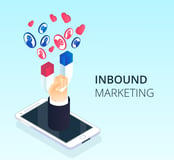Index Content
If you have read about Inbound Marketing before, you probably already know that beyond the integration of different Digital Marketing techniques - such as SEO, content creation or social media - its main objective is to generate business opportunities through 4 actions: attract consumers, convert them into leads or prospects, then into paying customers, and finally, into promoters of your products or services.
But for this methodology to be effective, a well-defined strategy must be designed where all participants are clear about the objectives we want to achieve. The creation of communication and content strategies is a complex job that involves knowing very well, not only our products and services, the market and our competitors, but also the behavioural patterns of our Buyer Persona; the good news is that there are five letters that will surely facilitate your work as a digital strategist: S.M.A.R.T.
what are SMART objectives?
As the acronym says, SMART objectives are smart, as they direct a company's strategic efforts to be specific, measurable, achievable, relevant and timely. SMART criteria, therefore, help you distinguish effective objectives from those that are not.
The SMART criteria refer to the 5 basic characteristics that each goal must have in order to be considered SMART:
- Specific : A truly specific objective includes what you want to achieve, how you want to achieve it and who will be responsible for it, as well as who you are targeting, whether it is a known audience, new markets or even your collaborators.
- Measurable : No objective is met from 0 to 100% automatically; since it is a process, you need to have indicators that will help you analyse compliance after certain periods of time.
- Attainable : Think about how your company interacts with the environment. Define your next steps based on the resources you already have: the number of employees, the level of specialisation of your teams, the technology you have, among other internal aspects. Then, study how the market behaves in relation to your sector and the closest competitors, and also examine the macroeconomic trends that influence consumption.
- Relevant : Recognise what is a relevant objective in two ways: first, by thinking creatively about what you see as opportunities, whether it is a product launch, growth in one of your product lines, or organisational changes; then develop the relevant research to find out whether these issues are relevant or need to be rethought.
- Timely : when does this goal have to be achieved? Define general, partial and daily time objectives: if you want to increase the number of employees from 50 to 80 in 1 year, in 6 months you should have 50% of new employees trained, and every day you should conduct 2 interviews to meet the total goal.
Advantages of the SMART methodology
Some of the advantages that the SMART methodology provides, and that you should take into account when deciding on this strategy, are:
- You increase your business vision: when you follow a SMART methodology in your company, you have a broad vision of your business. The more visibility you have of all the factors, efforts and resources you require, the easier it is to achieve your goals.
- You improve your planning: if you apply this methodology you have a better chance of establishing order in your business, whether in processes, systems, activities of each position, in order to operate with the same vision to achieve the planned results. With smart processes everything flows better and you avoid unnecessary risks in the operation of your company.
- You can focus on what is most important: knowing where you are going is fundamental to determine what you have to do, how and with what to get to that point. With this you can focus your actions on what you need, avoiding distractions or leaks of resources in aspects that will not help you to achieve a goal. It also helps you to establish priorities and prioritise from the most important to the least relevant.
- You have more control: another great advantage is the possibility to better allocate your human, physical and financial resources, which will generate savings. With SMART objectives you have more control over your budgets.
- You optimise communication: a SMART objective helps you to communicate more precisely what the company or a specific project is aiming for, so that all employees or members of your business can identify the goal and you can communicate your message in a concrete and direct way.
- You boost time management: when you establish a smart methodology you delegate the right activities at the right time; it is the best way to manage time in your company.
- You give your company a strategic profile: if you get used to thinking SMART you will always be strategic and with this your company will reinforce each of its areas to work smoothly, as true integrated gears. A business with a strategic profile stands out, positions itself, grows and differentiates itself from its competitors.
- You streamline your sales force: your sales team requires vision, certainty and tangible goals so that they can act in an agile way. You achieve this when you establish SMART objectives, with which they can be guided and orient their efforts aligned with your business strategy.
- You establish continuous improvement processes: when you have a broad business vision, control of your resources, planning and strategy, it is very easy to establish continuous improvement processes, because you have clear indicators of how you are doing, what progress is being made and whether you are achieving the objectives implemented.
- You increase your profitability: linked to the above, if your company assimilates the SMART methodology as part of its essence for all its activities and operations, you will surely achieve successful results and increase the profitability of your business.
Now that you know how to plan SMART objectives, start planning yours for your next strategy. Be sure to use this technique and remember that in digital marketing nothing is written, this is a process of constant feedback and as such, it must be enriched with new ideas permanently.
For some SMART examples click here.





